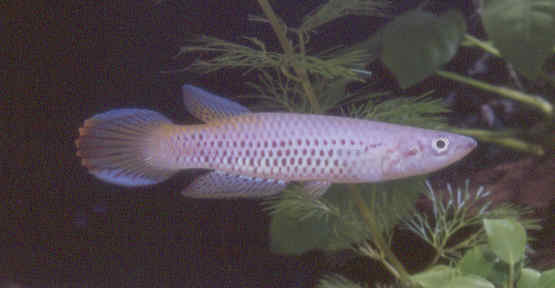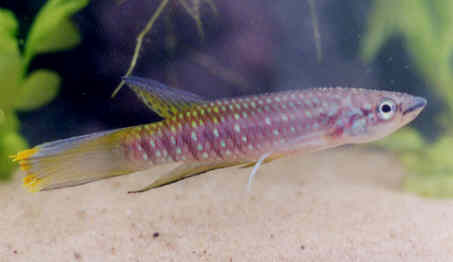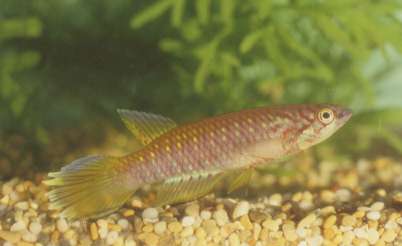Epiplatys fasciolatus fasciolatus (Günther 1866)

E.fasciolatus Bo. Photo courtesy of Ed Pürzl.
| Meaning of Name |
Refers to the striped or fasciated pattern on the body. |
||||||
| First Description |
Günther A. 1866. Catalogue of the fishes in the British Museum, Volume 6. The British Museum, London. 358. |
||||||
| Size |
9 cm. |
||||||
| Meristics |
|
||||||
| Karyotype |
n = 18-20, A = 35-38 (variable between different populations)(Scheel 1968, 1981). |
||||||
| Sub-Genus |
Epiplatys |
||||||
| Group |
fasciolatus |
||||||
| Synonyms |
|
||||||
|
Populations
|
Adonkia - Collected by Fred Wright, Rod Roberts & John Parker in the early part of 1976 in the Guma Valley, near Adonkia.
Commercial Imports - Most fish in circulation in the UK at least come from commercial imports. The 3 photos below came from the same exporter over a period of years & most likely collected in the same area. All are very similar.
|
||||||
| Type Locality |
Freetown, Sierra Leone (according to Berkenkamp & Etzel, 1989). |
||||||
| Distribution |
Widespread from coastal southern Guinea, through Sierra Leone & into coastal north of Liberia. http://homepage.uibk.ac.at/homepage/c102/c102mr/epiplaty/fasciola.htm |
||||||
| Habitat |
Coastal rivers, streams & swampy areas of coastal rainforest & forested savannah. |
||||||
| Distinguishing Characteristics |
Scheel in ROTOW 1 stated that the species could usually be identified by 'two thin red lines in the distant part of the anal fin and in the lower part of the caudal fin'. The clip below shows this well.
|
||||||
| Colour/Pattern Variability | High | ||||||
| History |
Boulenger gives the following collectors / locations in his 1915 Catalogue.
Günther described this species from four specimens collected in Sierra Leone in 1866. First reports of an aquarium kept strain comes in 1908 by Grote who reported fish he thought to be E.sexfasciatus from a small village near Conakry, Lower Guinée. These fish apparently, did not reach Hamburg alive. Arnold reported live fish reaching Germany from Sierra Leone in 1911. These fish were considered feeble with young fish growing slowly. Most of these young developed into males. This strain apparently survived the First World War. The species has been documented as being kept by Ohlendorf in 1917, Sachs in 1919 & Zindler in 1922 but this strain was later lost. Roloff reported the species being kept by German aquarists in 1935. He collected fish from Kissy on the Freetown peninsula in 1936 & brought back preserved fish which were identified by Ahl in 1937. In 1962, 1963 & 1965 Roloff collected the species in many locations in Sierra Leone & gave Scheel many strains for study. Daget & Iltis in 1965 considered lamottei & olbrechtsi to be subspecies of fasciolatus. This has not been generally accepted. It is interesting that the fish at the top of this page originated from the same general area as those imported in 1908 (unsuccessfully). History of the synonym Panchax fasciolatus In the main list above Ahl is credited with the description in 1924. In the Annals & Magazine of Natural History Vol.X, Tenth Series. 1932. J.R.Norman lists this fish as credited to Günther (no date) from type locality Sandaru. Collected by Mr.G.L.Bates, Sierra Leone early 1932. History of the synonym Epiplatys dorsalis Mayer 1936. Mayer had 2 males which he bought from Grelk. He was informed that these originated from Old Calabar, Nigeria although this was considered an unreliable source of information. He sent a male to Ahl who used the same name to described them as Mayer used 2 years previously. History of the synonym Epiplatys sexfasciatus leonensis Ahl 1937 In BKA newsletter July 1966 an article written by Scheel & translated by Erik Juhl-Sørensen referred to this subsp. from Sierra Leone which was said to have been discovered by E.Roloff. It is believed Ahl considered this a seperate subsp. on the basis of a dark longitudinal band on its sides. Scheel in ROTOW 1 reported that this characteristic is also found as a fear/pre-mating pattern in fasciolatus. History of the synonym Epiplatys matlocki Fowler 1950. Fowler used 25 specimens collected at Robertsport, western Liberia to describe the species in 1950. |
||||||
| Breeding Notes |
An easy fish to breed, you can easily become swamped with eggs. Water incubation takes around 14 days. Growth is quite rapid with sexual maturity being attained around 6 months. Hoedeman comments in his book that this species
does not like the addition of salt to the water & will not breed
well. Although the species comes from areas of coastal flooded biotopes
which receive salt water they are reportedly (in this book) not found
there. |
||||||
| Diameter of Egg | 1.3 - 1.4mm. | ||||||
| Remarks |
|






